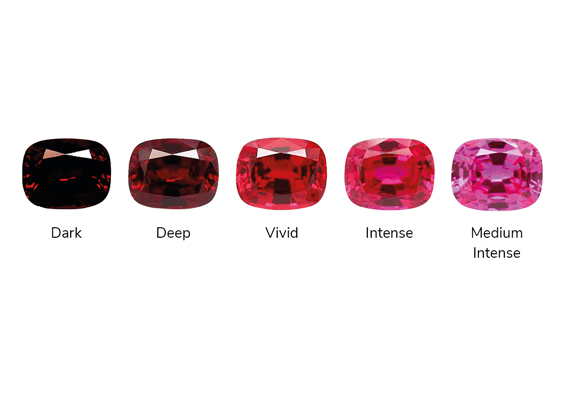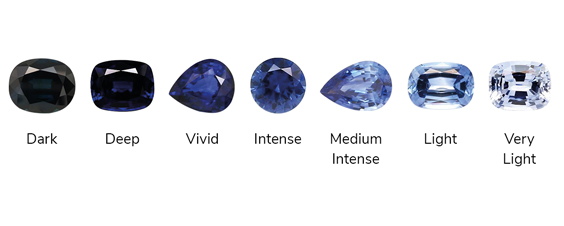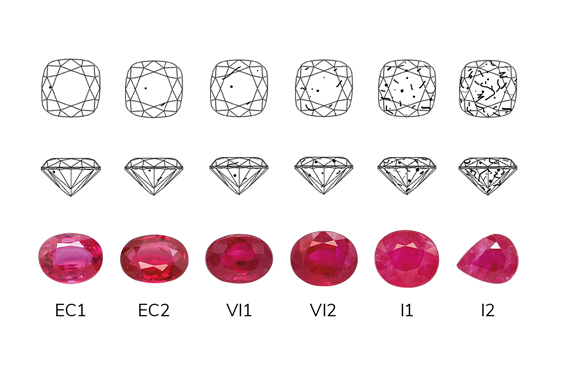What should I look for when purchasing gemstones?
Intensity of colour
Intensity of colour should always be your main focus when purchasing gemstones, as it will determine the long-term value of your stone.
The most sought after colour intensity is Vivid because it reaches the optimal balance of colour saturation. The more saturated or intense the colour, the darker your gemstone will appear, significantly lowering its value.
On the other hand, a faint intensity can change the colour of your gem altogether. A very light-coloured ruby, for example, becomes a pink ruby.

Unlike diamonds, there is no internationally accepted colour grading system for gemstones. 77 Diamonds have adopted the ICL’s seven levels of colour intensity:
- Dark: a moderate to strong saturation with a very dark tone.
- Deep: a moderate to strong saturation with a medium dark to dark tone.
- Vivid: a vivid saturation with a medium to medium dark tone. Considered the finest combination of tone and saturation.
- Intense: a moderate saturation with a medium light tone.
- Medium Intense: a moderate saturation with a light tone.
Sapphires benefit from two further levels of colour intensity:
- Light: a slightly greyish or brownish saturation with a light tone.
- Very Light: a greyish saturation with a very light tone.

Carat
The size of a gemstone is mainly determined by carat weight. One carat is equal to 0.2 grams and is often divided through a point system, where 100 points make up a single carat unit. The larger the gemstone, the rarer and more valuable it becomes.
Due to their rarity, the price of certain gemstones increases exponentially with size. For example, a 10.0 carat ruby can be, on average, a hundred times more expensive than a 1.0 carat ruby.
Clarity
The ICL grading system is very straightforward, as it is based on what can be seen by the unaided eye without using magnification.

Unlike diamonds, inclusions in gemstones are common, well-accepted and often serve to indicate the origin of the stone. There are three levels of clarity:
- “Eye Clean” (EC1 - EC2) indicates that inclusions are invisible to the unaided eye.
- “Visible inclusions” (VI1 - VI2) indicates that inclusions are only slightly visible to the unaided eye.
- “Included” (I1 - I2) indicates that inclusions are obvious to the unaided eye.
Origin
The origin of gemstones, unlike that of diamonds, can be easily traced due to the unique aspect of the inclusions found in each stone. You can look at them as gemstone “birthmarks”.
Origin has an important impact on the value of gemstones. Stones from certain locations, such as Kashmir sapphires or Burmese rubies, are extremely valuable due to heritage and scarcity.
Treatment
Most gemstones are regularly treated to enhance colour or clarity. This is a widely accepted practice in the jewellery trade and most methods have no harmful effect on the stone. Put simply, it is a method to speed up the process nature couldn’t finish.
Only the finest and rarest gemstones are unearthed in a perfect state without need for further treatment, making them significantly more valuable.
The most commonly used enhancements are through
heat, these include:
- Heat treatment (H).
- Heated treatment with flux (Hf1, Hf2, Hf3).
There are also treatments involving the use of
oil or resin to fill certain fissures in the stone and enhance clarity. These types of treatments are usually applied to emeralds and are commonly used in the industry.

At 77 Diamonds, we wish to offer only the most durable gemstones. For this reason, we do not sell items that have been treated through more abrasive methods as this weakens the gem. These procedures include heat treatments using lead glass, cobalt, beryllium or titanium.
Shape
The shape of a gemstone will not have an impact on price, as this is largely a matter of personal preference. The most common shapes are Round, Oval, Cushion, and Pear.

Gemstones usually combine two different cuts, the brilliant and the step, for an optimised balance of vivid colour and brilliance. Similar to diamonds, the crown of a gem is usually formed into a brilliant cut to add radiance, while the pavilion is step cut, allowing for intense colour and vibrancy.
We also offer less conventional shapes, arranged in the three following categories:
- Rectangle (Octagon, Fancy Octagon and Baguette).
- Square (Square, Princess and Asscher).
- Other (Kite, Trilliant, Shield and Tapered Baguette).
Emeralds are usually cut into a rectangular shape to ensure greater durability, as they are slightly more brittle than other gemstones.
Cost
Colour, clarity, origin, treatment and carat weight are all factors that will determine the final price of a gemstone. Bear in mind that high-quality gems are extremely rare and will benefit from a significant increase in value.
Before purchasing a gemstone, it is best to form an idea of the level of quality you are looking for. Try to decide what is most important to you and see how that correlates with your budget.